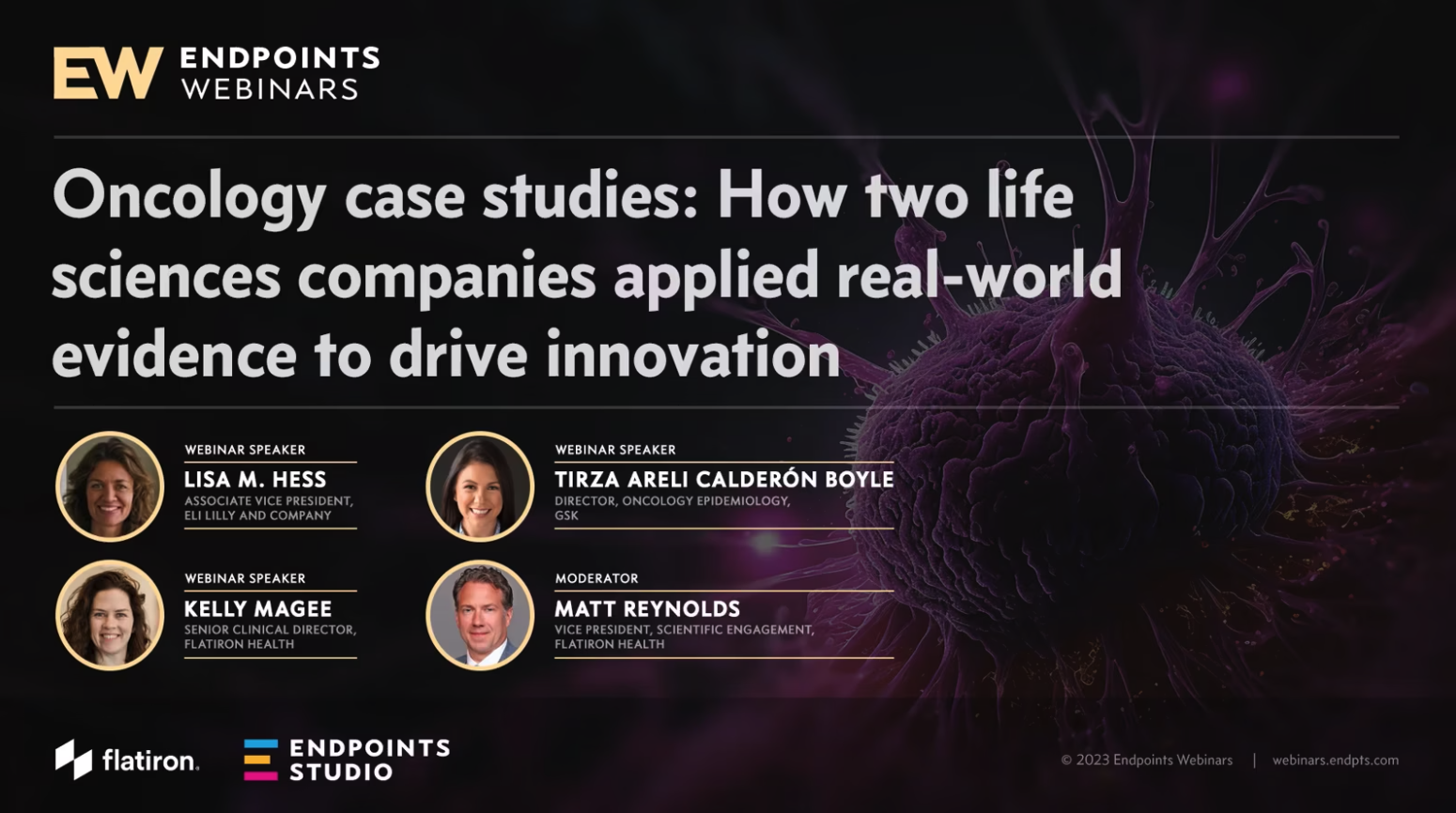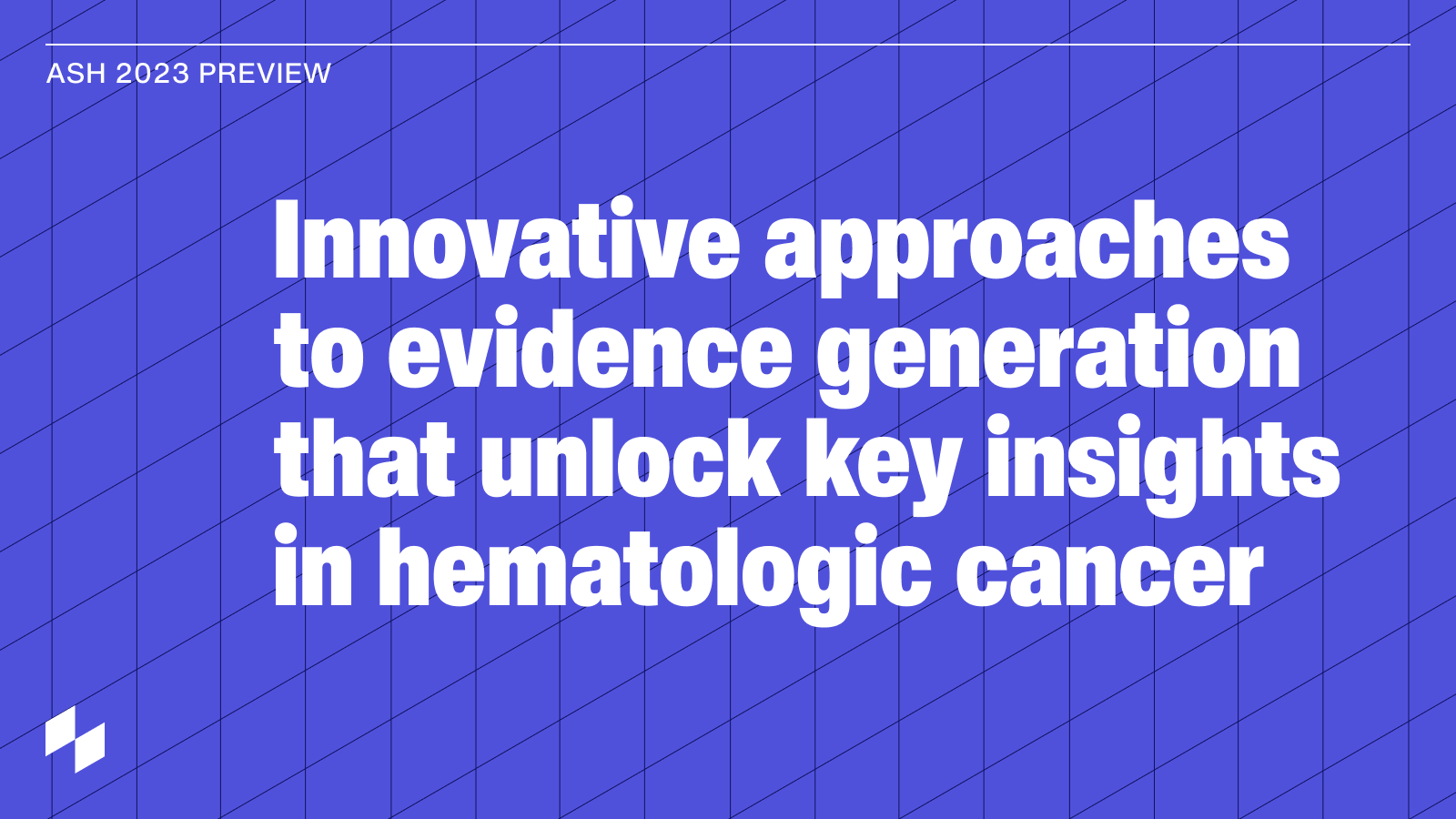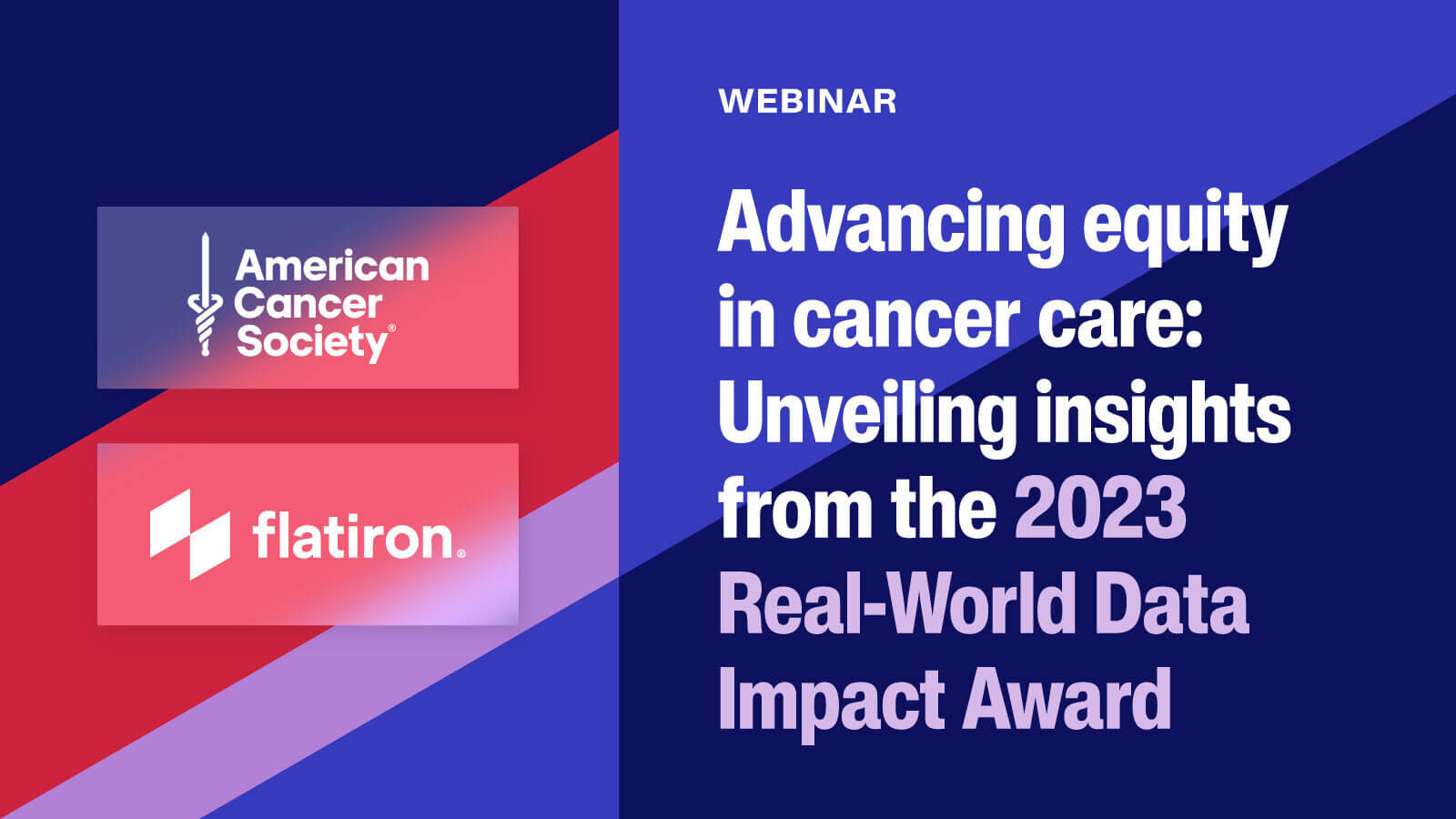Kiran Patel, MD explains in this case study how he and his team used EHR-derived real-world data with genomic information to support a new drug application in oncology.
This talk is part of the ResearchX session: Applying RWE to Regulatory Applications.
Sections include:
- Integrating Clinical & Genomics Real World Data to Support New Drug Application
- Postmarket Real World Data Perspectives: IBRANCE (palbociclib) Males Case
- Kadcyla (T-DM1) in HER2+ mBC Label Update on LVEF following a post approval commitment – based on RWD
- Getting Real: Real World Evidence in Oncology Drug Approvals

Transcript
Kiran Patel: Great, thank you, Jillian. Hi, good morning and good afternoon everyone. I'm going to be presenting today the case stud of integrating clinical and genomics real-world data to support the new drug application for Erdafitinib, the first FGFR inhibitor approved in patients with second-line advanced or metastatic urothelial cancer with FGFR positive alterations. Next slide.
My disclosure, I work for Janssen, and I have vested interest and options working for the company. Next slide. So, I'll start with a brief introduction in reference to the high unmet medical need and the reason to generate the real-world evidence data. Patients with advanced bladder cancer have a poor outcome. The available therapies and approved therapies are all single-agent chemotherapy in second-line setting. And those chemotherapies have a very limited response rate and very poor survival.
The IO agents most recently approved such as PD-1 inhibitors have improved outcomes with an objective response rate of approximately 20% and survival extending beyond 10 months. However, not all patients benefit. There are published literature with limited data showing that the responses to these IO agents vary by the TCGA subtypes. In particular patients with luminal 1 subtype bladder cancer may be immunologically cold and may respond poorly to PD-1 inhibition. And therefore, the additional treatment options are needed for these patients with advanced bladder cancer. If you go to the next slide.
FGFR alterations are observed in approximately 20 to 25% of the patients with bladder cancer and also been known that these alterations are associated with non-T-cell-inflamed bladder tumors. It's found largely in these patients with luminal 1 bladder cancer where the IO agents have demonstrated limited to low response rate as shown in this table below. If you go to the next slide.
The phase two study of Erdafitinib in the FGFR+ advanced bladder cancer started almost simultaneously at the time of the development of other IO agents in bladder cancer. This study was a single-arm phase two study to demonstrate the activity of FGFR inhibitor Erdafitinib in patients with advanced bladder cancer. If you go to the next slide.
While the study was ongoing, the treatment paradigm was shifting where anti-PD-1 agents were also in development at the same time, and due to high response rate, led to accelerated approval of these agents. So, there were some patients enrolled in the phase two study that had received prior IO agents such as anti-PD-1, and they're shown here where 33 out of 210 patients enrolled in the study had received prior anti-PD-1.
In those patients with prior PD-1, the response to those PD-1 therapies was very limited as demonstrated here with 6.1% response rate. There was also data with another FGFR inhibitor in development at that time that showed that in 10 patients enrolled with the FGFR3 overexpression none of those patients have response and only one patient has stable disease. Next slide, please.
So, that led us to understanding the unmet medical need in light of the emerging change in treatment paradigm for these patients where PD-1 patients had received approval there were two critical questions for us to address in light of that. Number one is to really understand if this population with FGFR alterations, a subset of those patients with FGFR alterations have a different prognostic value compared to other patients who does not have this alteration.
And then number two critical question for us to address was what is the predictive value of this alteration in the outcome of treatment with available anti-PD-1 agents for which there were two things we did. One was to compare with FGFR-altered versus non-FGFR-altered bladder cancer tumors with the anti-PD-1 treatment. And number two was to do an indirect match comparison of FGFR-altered bladder cancer patients with the BLC2001 study patients enrolled with Erdafitinib versus the anti-PD-1 therapy. If you go to the next slide.
So, we used the Flatiron/Foundation Medicine real-world data. This was a combination of clinical and genomic data set linking the clinical information that includes full treatment histories and survival data from the Flatiron database. And using the genomic data set of FGFR alterations using the FoundationOne next-gen sequencing. So, in the data set of 25,000 plus patients, we identified 5,000 plus patients with advanced bladder cancer in the database of which 426 patients had the diagnosis of bladder cancer as well as had the Foundation Medicine genomic data set. Of which 300 or so patients have received treatment, and of those 300 patients, 124 patients have received anti-PD-1 treatment.
So, to answer the question, the first thing was to look at the demographics, and yes, please go to the next slide. We looked at the demographic and baseline characteristics of patients who had FGFR+ versus FGFR- disease. And you can see there was a very clear balance between two, but I also want to point out that the ECOG performance status, which is one of the key indicator to enroll patients in clinical study, approximately 80% of patients did not have the ECOG performance status. Go to the next slide.
Looking at the prognostic value, there was a trend in demonstrating shorter median survival in patients who had FGFR+ disease versus patients who did not. You can see from the numbers here the median overall survival was 7.2 months in the FGFR+ patients versus nine in the FGFR-. The hazard ratio was trending towards the direction to demonstrate benefit, although it was not statistically significant. Go to the next slide.
Looking at the predictive value of the FGFR with the use of anti-PD-1 therapy, patients who had FGFR+ disease had a median survival of 3.1 months, and in comparison to that, the patients with FGFR- had a median survival of 6.1 months. Again, trending positive with the hazard ratio of 1.33, but not statistically significant. This was maintained while doing the bivariate as well as multivariate Cox regression analysis adjusting for the baseline covariates. Go to the next slide, please.
And in looking at the indirect comparison using propensity score analysis where the treatment for overlapping population was adjusted for key variables such as line of therapy, age, sex, hemoglobin, smoking history as such, there was a clear difference in terms of the median survival in patients with FGFR+ disease. So, this is a clinical trial data set now doing an indirect comparison to that versus the data set from the Flatiron/Foundation Medicine showing 3.1 months survival in patients who have received anti-PD-1. So, if you go to the next slide, please.
In summary, we were able to demonstrate using the real-world evidence data to support the unmet medical need in patients with FGFR+ bladder cancer. Next slide, please. So, we'd like to do some comparison to this data set that I shared against the clinical literature and trials available. Of course, these are two different data sets. We know the clinical trials and literature data set that exist out there.
The Flatiron/Foundation Medicine data is contemporaneous. It has broad access to available therapies, and also, it's a comprehensive genomic profile. So, it's really combining two data sets together. That was the advantage. We were looking for specific population with FGFR alterations, and this data set was able to help support that there was no data out there in clinical trials or literature that can help us support that. If you go to the next slide.
However, there are downside to this and there are limitations to this, and some of the clinical limitations are, as you would expect, there is a selection bias with this type of data set. With the Flatiron data set, it was primarily at that time community-based clinics, and so the data set we received was based upon community settings or patients who are treated in the community setting versus clinical trial data set where all patients are treated at the academic institutions.
In addition to that, there are some missing elements as I mentioned ECOG performance status. There was also missing information on smoking history, hemoglobin, which are key confounding variables for patients with bladder cancer. In addition to that, there were different selection of comparison group, there were differential treatment misclassification, and also there were some statistical limitations especially with the small sample size of patients.
But there were a couple of key things that were also quite intriguing while doing this analysis. One was a survivorship bias whereby we have to exclude subjects who did not undergo molecular testing. Since we're combining two different data sets, that's something we had to apply to be able to make sure that we can bring more consistency in terms of the analysis. And due to the survivorship bias, we had to apply this delayed entry model using left truncation method, which I was not familiar with before we started the analysis. But I learned quite a bit during the assessment to be able to apply this to avoid the survivorship bias that I mentioned before. Go to the next slide.
In addition to those limitations, there are other considerations for real-world studies that could be applied for any studies, but also something that we learned during this process. As I mentioned, the adequate sample size is critical. Linkage to other data sources such as a claims database to capture complete information is also very critical because missing information could also lead to a very different outcome. And knowing that this is a real-world evidence data it's important to make sure that the missingness of the data is limited to some extent so that we can appropriately analyze and interpret the data.
Similarly, applying inclusion/exclusion criteria, especially looking at the control cohort. If the comparison is to a clinical study, it's important to apply the same criteria to minimize other variables. As well as minimizing the ascertainment bias especially with the exposure and outcomes that are listed here. I think it's important to really make sure that all efforts are made to make sure these important confounding factors are balanced before considering the analysis. If you go to the next slide.
And there are additional other considerations that were also learned during the process. Working with Flatiron as well as working with other vendors that allow sufficient time for data privacy issues that emerges from using this data set. So, it's good to manage that quite early on. Consider regulatory filing in contractual language. I always have come to realization that real-world evidence data could be categorized in different ways. The regulatory grade data set has to meet the regulatory standards, and so it's good to have that upfront agreement with the vendor in the contractual language.
The protocol and statistical plan must be in place prior to any analysis, so this is no different than conducting clinical study. The real-world data should also have a protocol and a clear understanding of what we plan to analyze. And then the rigor of data preparation for real-world evidence is equal to that of the submission of clinical trial data. So, again, applying those same principles in terms of the quality is critical for using real-world evidence. Next slide.
So, here is an overall conclusion leveraging real-world data. We were able to understand exactly what the issue was for this submission, which was that there are available therapies that has emerged as a standard of care. We use real-world data using Flatiron and Foundation Medicine to be able to combine genomics and clinical data set to be able to support this data set as a supportive submission for the new drug application for Erdafitinib. And that's my last slide. Thank you so much.


